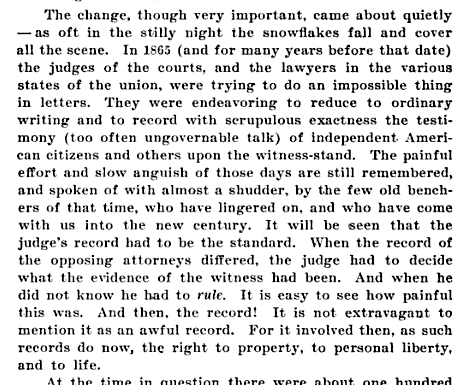
Albany’s Philander Deming told the story of his innovation of court stenography in the third person, referring to himself (in a style of modesty then current, perhaps) as Mr. Gray:
“In 1865 … the judges of the courts, and the lawyers in the various states of the union, were trying to do an impossible thing in letters. They were endeavoring to reduce to ordinary writing and to record with scrupulous exactness the testimony (too often ungovernable talk) of independent American citizens and others upon the witness-stand. The painful effort and slow anguish of those days are still remembered, and spoken of with almost a shudder, by the few old benchers of that time, who have lingered on, and who have come with us into the new century.”
He wrote that there were at the time perhaps 125 competent shorthand reporters in the entire country, doing congressional, legislative and newspaper work. “Among these shorthand writers was one (Mr. Deming) whom it is convenient to mention as Alexander Gray, although in point of fact your narrator is mrerely telling his own experience. Mr. Gray came to Albany early in the ‘sixties. It was among his plans to introduce shorthand into the supreme court circuits of the state held in Albany and adjacent counties.”
His innovation was not immediately welcomed. One supreme court judge he approached did not see how anyone could write more rapidly than he did. But another judge on a high-profile case was willing if the attorneys would consent. The district attorney rebuffed him, and the attorney for the defense argued that his shorthand would be useless as no one else could read his notes. Deming (or Gray) attended the trial, taking shorthand notes all along, and related in great detail the progression of the trial to a point at which it is critical to know whether the prosecution has opened the door to a line of questioning, and a lengthy argument ensued over whether a question had been asked and answered.
“In the meantime, who is that quiet person seated at the long table, on the opposite side from the counsel and yet near to the witness? He has been there during the circuit, writing, but wholly ignored by the court and counsel. We recognize in him the reporter who was so sharply treated by the lawyers in their offices. It must be that the judge has kindly allowed Mr. Gray a seat within the bar. Let us look over his shoulder and see the carefully written pages. Every word, every comma, of all that has been done, has been recorded. The old, slow method, in which the court and attorneys have kept their minutes, has given the shorthand man time for this. While the others have been scratching and perspiring (and keeping the witnesses down to half-speed) to get the substance, Mr. Gray has leisurely written all the words of every question and every answer in exact and (to him) very legible shorthand characters.”
He copies out the exchange in question and hands it to the defense, and all agree that his accurate recording of the conversation is the final word. “There is hand-shaking and rejoicing, and the accused goes his way to his home and to freedom. “But how about the stenographer? He has succeeded only too well for his own peace and rest. From that day and hour he found it impossible to do the work forced upon his attention … It took time for new men to become qualified to do this new kind of expert work, but more than a dozen years before the close of the nineteenth century the advance had been pretty generally made. The note books of the reporters had descended upon the court rooms, and the scene was changed. The pens had been laid aside. The examination of witnesses moved smoothly on, no longer checked or broken by those painful delays which had been required when the court and the lawyers were writing the evidence. The tediousness had departed; the court room had become a pleasant place … And the judges, clothed with a new dignity, sitting bravely upright and in their right minds, had become the special friends of the stenographers.”

Leave a Reply